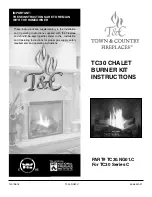
www.fmiproducts.com
125077-01D
5
PRODUCT FEATURES
Figure 2 - Common Fireplace Locations
Flush with a wall
Through exterior wall
enclosed in a chase
Corner
installation
PRE-INSTALLATION
Figure 3 - Fireplace Bottom Dimensions
D
RW
FW
27
5
/
8
"
26"
43"
These are a few facts that can help you un
-
derstand and enjoy your direct vent fireplace:
• The venting system may be routed to the
outside of your home in several ways. It
may vent through the roof (vertical) or it
may vent to an outside/exterior wall (hori
-
zontal). The vent pipe installation is very
important to allow for proper operation.
You must follow the venting instructions
very carefully for either vertical or horizontal
applications.
• This fireplace may be installed in any room
of your house provided all local codes and
these installation instructions are followed.
LOCATION AND SPACE
REQUIREMENTS
Determine the safest and most efficient loca
-
tion for your direct vent fireplace. Make sure
that rafters and wall studs are not in the way of
the venting system. Choose a location where
the heat output is not affected by drafts, air
conditioning ducts, windows or doors. Figure
2 shows some common locations. Be aware
of all restrictions and precautions before
deciding the exact location for your fireplace
and termination cap.
When deciding the location of your fireplace,
follow these rules:
• Do not connect this fireplace venting to a
chimney flue serving a separate solid-fuel
burning fireplace or appliance.
• Due to high temperatures, do not locate this
fireplace in high traffic areas, windy or drafty
areas or near furniture or draperies.
• Proper clearances must be maintained.
• If your fireplace is to be installed directly on
carpeting, vinyl tile or any combustible mate
-
rial other than wood, it must be installed on a
metal or wood panel extending the full width
and depth of the fireplace (see Figure 3).
• Your fireplace is designed to be used in
zero clearance installations. Wall or fram
-
ing material can be placed directly against
any exterior surface on back, sides or top
of your fireplace, except where standoff
spacers are integrally attached. If standoff
spacers are attached to your fireplace,
these spacers can be placed directly
against wall or framing material. See fram
-
ing details, page 6.
• When locating termination cap, it is impor
-
tant to observe the minimum clearances
shown in Figure 7, page 7.
• If recessing into a wall, you can avoid extra
framing by positioning your fireplace against
an already existing framing member.
• Do not recess termination cap into a wall
or siding.
• You may paint the termination cap with
450º F (232º C) heat-resistant paint to
coordinate with the exterior finish.
• There must not be any obstruction such as
• Each time you turn on your fireplace, you
may notice some amount of condensation
on the inside of the fireplace glass. This
is normal and will disappear after 10-20
minutes of operation.
• Your direct vent gas fireplace system
(fireplace and venting) is a balanced and
sealed gas operating unit. It requires ap
-
proximately 10-20 minutes of operating
time before the flame pattern stabilizes.
• Models ending in -C have a standard glass
inner door. Models ending in -CC have the
standard glass inner door with a middle
glass door and outer cool touch glass door.






































